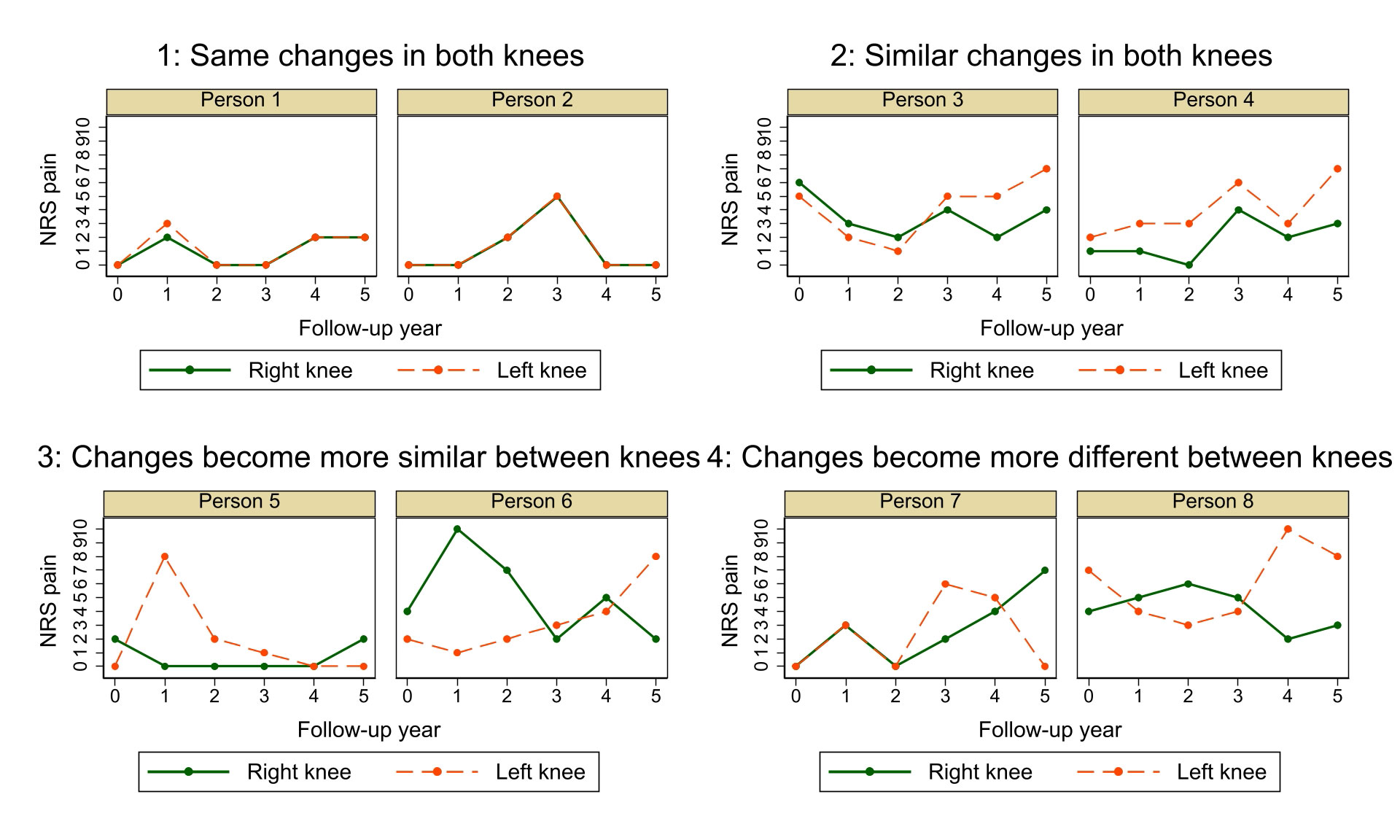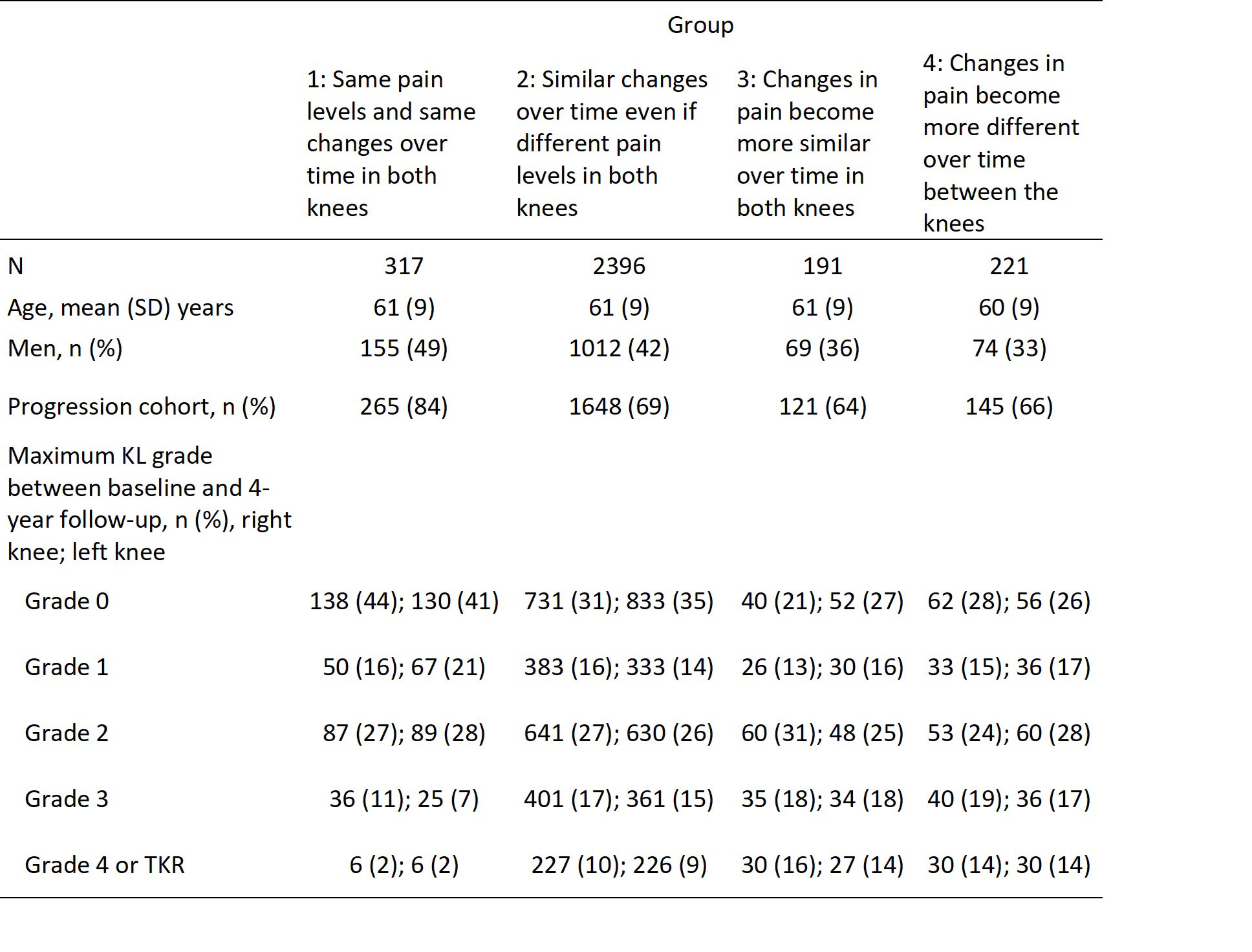Session Information
Session Type: Poster Session D
Session Time: 1:00PM-3:00PM
Background/Purpose: Pain in knee osteoarthritis (OA) is often known to fluctuate. However, there is limed knowledge of the pain fluctuations in between knees within the same person. Our aims were: 1) To estimate to what degree knee pain co-fluctuates in two knees within the same person. 2) Identify persons who have high degree of co-fluctuation indicative of systemic reasons of pain, and persons with more distinct pain patterns in each knee suggesting local reasons for pain.
Methods: We included 3310 subjects from OAI incidence or progression cohorts with non-missing values of pain in last 7 days (NRS range 0 to 10) at each annual follow-up between baseline and 5 years in both knees. To evaluate changes in pain in each knee, we created a new variable, change in NRS pain over 1 year of follow-up. Then, we calculated the absolute difference in change per year between two knees within a person. Using group trajectory modeling, allowing for polynomial shape of the trajectories, we identified clusters of persons with similar trajectories of change in pain over time in both knees, and those with knee-specific trajectories of change. We evaluated 2 to 6 groups and selected a 4-group solution based on acceptable out-of-sample (20% of the whole study sample) group membership posterior probabilities with mean of at least ~0.8 for all groups and group sizes of at least 5% of the study sample.
Results: The knee pain was similar across all follow-up time points (apart from baseline that had higher proportion of persons reporting pain) and very similar between right and left knees. At each follow-up, for ~40% of knees, participants reported no pain. Among knees with pain, the mean pain levels over 5 years ranged 3.7-4.0 (SD 2.2-2.3) in right knee and 3.9-4.1 (SD 2.3-2.4) in the left knee. 185 persons had no knee pain in either knee during the follow-up and were thus excluded from further analysis. During each 1-year follow-up time, ~50% reported changes in pain in both knees that were the same or differed by 1 NRS point only. ~30% reported changes in pain that differed by 2-3 NRS points between two knees within one person. ~20% of participants reported annual change in pain level that differed >4 NRS points between the two knees. We found 4 groups with distinct patterns of within-person changes in knee pain over time.(Figure 1). Group 1: 10% of persons reported essentially the same changes in pain for both knees and practically the same levels of pain. Group 2: 77% of persons reported similar magnitude of changes in both knees, even if having often different levels of pain in each knee. Groups 3 and 4: 13% had different changes in pain between the knees – where in one subgroup (6%) the two knees converge to become more similar, while in the other subgroup (7%) the two knees diverge over time to become different. Mean age was similar between the 4 groups, but sex distribution was markedly different, with relatively more male participants reporting similar pain in both knees. Those with same pattern of change in both knees were also more often from the progression cohort. (Table 1)
Conclusion: As many as 85% of persons report similar fluctuations of pain in both knees. Only ~15% report distinct knee pain fluctuations in each knee. Systemic components of pain and use of pain medication may contribute.
To cite this abstract in AMA style:
Englund M, Neogi T, Turkiewicz A. Co-fluctuations of Knee Pain Between Knees in the Same Person: Data from the Osteoarthritis Initiative (OAI) [abstract]. Arthritis Rheumatol. 2022; 74 (suppl 9). https://acrabstracts.org/abstract/co-fluctuations-of-knee-pain-between-knees-in-the-same-person-data-from-the-osteoarthritis-initiative-oai/. Accessed .« Back to ACR Convergence 2022
ACR Meeting Abstracts - https://acrabstracts.org/abstract/co-fluctuations-of-knee-pain-between-knees-in-the-same-person-data-from-the-osteoarthritis-initiative-oai/


